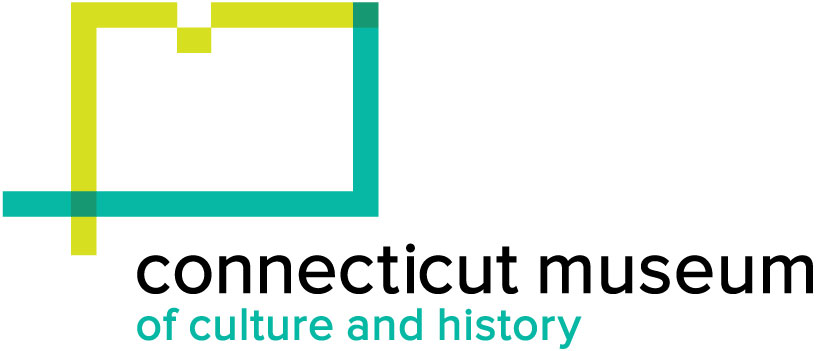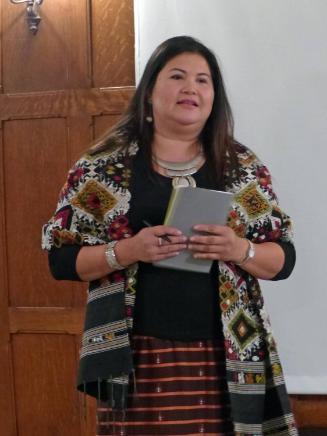Voices of Wisdom Program 2016: Marek Czarnecki, Sandra Taitt Eady, and Manola Sidara
SubjectPortrait of
Marek Czarnecki
(Polish-American)
SubjectPortrait of
Manola Sidara
(Laotian)
Date2016 October 6
Mediumborn digital video
DimensionsDuration: 37 Minutes, 59 Seconds
ClassificationsGraphics
Credit LineConnecticut Cultural Heritage Arts Program collections
CopyrightIn Copyright
Object number2015.196.852.1
DescriptionBorn digital video of Marek Czarnecki, Sandra Taitt Eady, and the beginning of Manola Sidara presentations at the Voices of Wisdom event held in conjuction with the Connecticut Historical Society exhibition, "Growing Up in Connecticut" on October 6, 2016. Marek Czarnecki, an iconographer from the Bristol Polish community, speaks about growing up. Sandra Taitt Eady, a geneologist from the Barbadian community describes her experiences. Manola Sidara, a Lao dancer, educator, and chef who came to the United States as a refugee tells her story (continued in 2015.196.852.2).
NotesSubject Note: To coincide with the 2016 Connecticut Historical Society exhibition, "Growing Up in Connecticut," the Connecticut Cultural Heritage Arts Program presented an evening of informal conversation featuring stories and oral narrative on this topic with several speakers from a diverse range of Connecticut communities. Artists and speakers included Manola Sidara, a Lao dancer, educator, and chef who came to the U.S. as a refugee and settled in Connecticut where she is raising two daughters; Leticia Cotto, a librarian and educator from a Puerto Rican family that traveled back often to the island; Marek Czarnecki, an iconographer from the Bristol Polish community; Ruth Garby Torres, a Schaghticoke native educator; and Sandra Taitt-Eady, a geneologist and oral historian from Barbados. The event was the second in the Voices of Wisdom series that presented several of the state’s artists and tradition bearers who related their unique experiences and perspectives from other cultures. Many of these skilled speakers also recited stories of how they and their group immigrated to Connecticut. The events gave audiences a chance to hear oral traditions and cultural narratives important to a variety of groups of people who live in Connecticut, and to experience these stories in their native languages. The historical and cultural content offer insight into the speakers’ resilience, values, wisdom and humor, also honoring the language diversity and poetry that can be found in the cultural expressions of ordinary people with extraordinary knowledge and gifts of speech. Rather than professional or performance-oriented storytelling, Voices of Wisdom featured narratives grounded in the speakers’ personal experience and cultural roots.
Biographical Note: Marek Czarnecki began writing icons in 1990 for his home parish of St. Stanislaus Kostka in Bristol, CT, in his first studio there. It was appropriate for this first generation Polish-American that his first icon would be of Our Lady of Czestochowa, the Black Madonna of Poland. Iconography is a fundamental liturgical art form that provides authentic, meaningful and dignified images which exemplify the larger consciousness of the Christian Church. Icons carry a patrimony of both theology and art, conveying essential dogmatic and biographical information and embodying the presence of the holy ones depicted. After studying with several iconography teachers, Marek began a life-long apprenticeship with master iconographer Ksenia Pokrovskaya in 1999 until her passing in 2013. He has translated her teachings into an English language technical manual for iconographers, and taught workshops with her at several national sites, including St. Tikhon's Seminary in South Canaan, PA. Following established tradition, Marek’s icons are made with natural materials; the foundation is linen glued to a wood panel and primed with a marble-based gesso. Painted with egg tempera mixed with natural earth and mineral pigments, the halos and backgrounds are gilded with 22 karat gold. The icon is then varnished with copal resin.
Marek’s icons can be found in in the homes and chapels of individuals, as well as churches across the country, including the Catholic Cathedral of the Immaculate Conception in Springfield, IL, the Franciscan University of Steubenville, St. Thomas More Chapel at Yale University, and Sean Cardinal O'Malley. His icon of "Christ the Eternal High Priest", originally written for a seminary chapel, gained him international attention when it was chosen by the United States Council of Catholic Bishops as the image to represent "The Year of the Priest". This icon was widely distributed; more than a million copies were printed, reproduced and used in dioceses as distant as London, Stockholm, Singapore, and Sydney. Marek is also a skilled restoration artist, working with statues from churches across the country, and he creates ornaments and installations to mark festivals and holy seasons in his parish church of St. Stanislaus in Bristol Connecticut.
Marek has helped edit the book, "Hidden and Triumphant: The Struggle to Save Russian Iconography in Twentieth Century Russia" (Paraclete Press, 2010). He continues to teach students and write icons out of his home studio in Meriden, CT. He has won a CT Commission on the Arts Painting Fellowship in 1996 and 2004, the 1998 American Council for Polish Culture Award, the 2006 Polish American Historical Association Outstanding Achievement Award, and a Southern New England Traditional Arts Apprenticeship Grant to teach an advanced student. Articles on his work have appeared in the Hartford Courant, St. Anthony Messenger, Catholic Digest, Our Sunday Visitor, and New York Times. His website is www.seraphicrestorations.com
Biographical Note: Sandra Taitt-Eaddy grew up in Barbados and has a great interest in geneology and oral history, that helps connect her to her roots, her community and its life, and her grandparents and their stories. She has a masters degree in public history, is active with the Barbados Society here in Greater Hartford and is deeply committed to social justice work.
Biographical Note: Manola Sidara is a Lao dance educator and community activist whose life has been devoted to serving her community. Born in 1969, in Vientiane, Laos, Manola joined the National Dance School at the age of five, along with her sister. After her family fled Laos, she continued learning traditional dance with master dancer Sone Norasing in Colorado until moving to Connecticut in 1989. From her grandmother and aunts Manola learned to make pah khuane, the ornaments of bamboo leaves and flowers which are part of every Lao ceremony and celebration in both temple and home. She worked as a wedding consultant, organizing all the arrangements for traditional Lao weddings, and became known as a brilliant cake decorator. Manola helped to produce the exhibit "The Ties That Bind: Southeast Asian Wedding Traditions" at the Institute for Community Research (ICR) in 1995. In 1999-2000, she served as the Bilingual Program Assistant at Garfield School in Bridgeport, teaching ESOL, computers, and cultural awareness to elementary school children both Lao and Latino. Manola taught traditional dance at the Lao Saturday School in New Britain from its inception. With her high-school age students from the school, Manola formed the Lao Narthasin Dance Troupe, instructing the members in classical Laotian dance, folk dances of different ethnic groups in Laos, and traditional values and manners such as respectful behavior, honoring elders, and service to the family and community. The dance group, which has performed throughout Connecticut and Rhode Island at cultural centers and Lao temples, now includes a third generation of dancers. From 1998 to 2001, Manola was the New Britain Coordinator for the Urban Artists Initiative, a statewide training program run by the Connecticut Commission on the Arts and the Institute for Community Research. In 2001, Manola received an award from the Lao Association of Connecticut at New Year for her work with the Lao Narthasin dancers and was selected as a Connecticut Commission on the Arts Master Teaching Artist. In 2011, Manola coordinated the community oral history project, After the Trauma: Holocaust Survivors and Laotian Refugees Confront the Past, displayed at the University of Hartford. Manola is also known as a master chef at East West Grille, her award-winning and beloved Lao-Thai restaurant on New Park Avenue in Hartford from 2000-2019, and the East-West Grille Food Truck. Manola is very active in assisting the Lao Temple in Morris, Connecticut, with cultural programming, social service, and providing food for the monks and their ceremonies. For Manola, her tireless activities in dance, education, ceremonial decorations, and cooking all promote wellness, spirituality, bonding, and healing.
Additional audio, video, and photographic materials exist in the archive relating to this community and its artists.
Cataloging Note: This project was made possible in part by the Institute of Museum and Library Services MA-245929-OMS-20.
Status
Not on viewGraciela Quiñones-Rodriguez
2004 February 21











